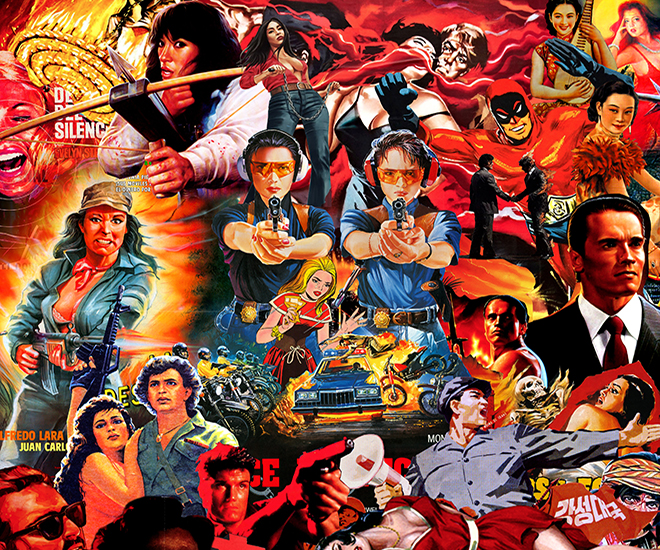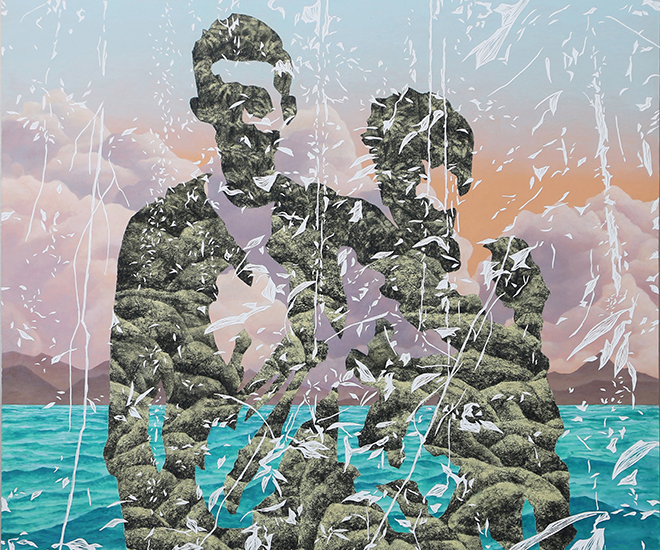Chain of Custody: Blockchain Technology in the Art Industry
Unveiling the interface between blockchain technology and art
Blockchain technology is considered disruptive because of its immutability, security and decentralisation. While the technology has been embraced most visibly in the fintech sector, how significant is it in the art industry? This article evaluates the transformative value of blockchain by examining how it can be used to establish scarcity in a digital environment, enable verification of authenticity and even facilitate the decentralised ownership of art.

Proof-of-work or proof of love? The Forever Rose sets new standards for Valentine’s Day gifts. Image courtesy Gifto Protocol.
Establishing Scarcity
A major stumbling block for artists in the virtual space is the difficulty of preventing their digital art from being copied. While various digital tools are available to restrict copying, such as Exif’s smart watermarks which are only triggered to appear when copying is attempted (even by use of the print screen function), blockchain technology instead empowers artists to preserve the value of original pieces regardless of how many copies are made.
This outcome is achieved by creating artificial scarcity. In summary, each piece of digital art is linked to a unique digital certificate and recorded on a blockchain. The record forms an immutable and reliable source of information about the artwork, including the date of creation and the number of copies made. Artists will therefore have a transparent and efficient mechanism to prove that only a finite number of those digital art pieces were ever made, thereby distinguishing them from illegitimate copies and preserving the value of the originals.
Artificial scarcity can be enforced because of two fundamental properties of blockchain technology. First, entries are protected by cryptography, making unauthorised transactions and alterations of past entries easily detectable. Second, blockchain is a distributed database with records stored on multiple systems rather than a single central server. This makes it virtually impossible for a single or small group of participants to overwrite records or add false entries. Unauthorised copies can be easily detected even if they look identical to the original piece.
The types of digital art emerging from blockchain-based ecosystems are diverse. On Valentine’s Day of 2018, artist Kevin Abosch collaborated with Gifto, a gifting protocol which allows users to send content creators virtual gifts with real world value, to create the Forever Rose. This one-of-a-kind digital artwork was sold for a ground-breaking USD 1 million and the proceeds were donated to the CoderDojo Foundation.
Other blockchain protocols invite artists to submit art to be stored on-chain, and to stipulate the number of pieces intended to be in circulation. Mechanisms to ensure the originality of submissions can also be incorporated. For example, the social networking platform DADA requires that art pieces be created directly on the platform, to reduce the risk of users simply uploading copies.
Blockchain technology has also enabled a new class of digital art collectibles. CryptoKitties, a game built on the Ethereum network, allows users to breed, own and trade digital cats of unique design. Each CryptoKitty and its “genetic code” is programmed as a token based on the ERC-721 standard, which simultaneously represents both the artwork and the digital certificate proving its scarcity.
The game has also redefined scarcity and ownership of digital art as a user can truly own a CryptoKitty by storing it on his or her electronic wallet. If diligently safeguarded, the CryptoKitty cannot be taken away, destroyed or copied by others. Less sentimental cat owners can also trade the CryptoKitties. In early December 2017, certain exceptional CryptoKitties traded for more than USD100,000. While some believed the novelty of CryptoKitties has been declining, a digital art auction conducted on 12 May 2018 proved cynics wrong when the exclusive Celestial Cyber Dimension was sold for USD140,000. This CryptoKitty was custom made by the CryptoKitties’ Director of Art and features a tangible statuette that encloses the CryptoKitty’s corresponding non-fungible ERC-721 token.
There is now a crypto safari of sorts across various blockchain protocols, featuring digital bunnies, dogs, alpacas and even frogs. Despite (or arguably because of) the notoriety of the Pepe imagery, there is a thriving market for Pepe-inspired digital art. Each Rare Pepe is linked to a digital token on the Counterparty Protocol, and subsequently displayed in the Rare Pepe Directory. January 2018 saw New York City hosting a Rare Pepe auction, where digital art like the Homer Pepe was sold for almost USD40,000.
Digital art on blockchain technology can also take more abstract forms. Aside from contributing to the Forever Rose, Abosch also pioneered the IAMA Coin project. He created 10 million ERC-20 tokens on the Ethereum blockchain and characterised these as individual pieces of the digital art, notwithstanding the absence of any visual representation. However, the tokens are not just an unorthodox representation of digital art as they may be tradable for Abosch’s physical artwork in the future.

You only need a digital wallet and some Ethers to feed these kitties. Image from CryptoKitties for Press.
Verification
Blockchain’s function as an immutable and secure ledger is as valuable to investors and collectors as it is to artists. The technology has been employed by protocols such as Verisart and Artex, which generate and store digital certificates after verifying the authenticity of artwork. As such, investors and collectors can rely on their platforms as a trusted database of authentic artwork when shopping for their next purchase. Blockchain-based VooGlue platform even adds a visual element to this proof of origin by “glue-ing” a time lapse video depicting the creation process of the artwork to the actual article. The video is available to users viewing the piece of art through the VooGlue app.
However, competitors and even fraudsters have quickly caught up with innovations in the blockchain space. Although the integration of blockchain technology in the art industry is relatively nascent, there are already multiple blockchain-based protocols providing solutions for verifying authenticity and tracking provenance. Aside from having to compare the competing blockchain-based protocols, users also face risks such as fake landing pages, phishing websites and fraudulent electronic wallets. An average user may not know which platforms to trust and which digital certificates are genuine.
As such, while blockchain technology offers a secure method for storing information, the use of such applications is still subject to many of the existing barriers in the art industry, such as information asymmetry and the need to navigate multiple sources of information. That said, the building momentum of the blockchain ecosystem generates opportunities for interoperability and scalability. With collaboration between multiple protocols offering similar verification functions, it may be possible to generate a larger infrastructure that allows users to check digital certificates across different protocols with ease.

The ubiquitous Pepe face which has spawned a million memes. Image from Pixabay Creative Commons.
Decentralisation
As blockchains are based on peer-to-peer networks without a central server, they can also support direct transactions between individuals. Perhaps the most well known blockchain is Bitcoin, which allows one party to send the digital currency to another in any part of the world, and without the involvement of any bank or other traditional electronic payment intermediary.
In the art space, the Maecenas protocol aims to be an open exchange supporting the decentralized sale and purchase of fine art without intermediaries. Further, artwork listed on the platform will be “tokenised” into smaller shares that can be purchased by multiple parties. Ideally, any interested party could own a piece of art with a small amount of capital. They also would not need to liaise with exclusive auction houses and art dealers in order to gain access. Meanwhile, existing owners can raise money by “listing” their fine art on the platform for purchase by new minority owners.
While this tokenisation structure bears similarities to shares in companies, the rights, liabilities and best practices for decentralised ownership on the blockchain space are less certain. Once an investor has purchased a certain number of shares and is recorded as their owner, under what circumstances can such ownership be challenged? If an investor is made bankrupt, will claims by creditors have any bearing on how a smart contract is executed? Do minority owners have any input on how and where the artwork is exhibited?
It is clear that even a seemingly straightforward application of technology has profound implications. Reference to social and economic norms will be crucial while navigating the legal pronouncements and rules issued by regulators on what often appears to be a piecemeal basis.
Conclusion
Blockchain technology has inspired artists all over the world. The industrial city of Kranj, Slovenia revealed its giant representation of Bitcoin in the middle of a traffic roundabout earlier this year. On the other side of the world, New York City’s Ethereal Summit showcased immersive artwork such as the Bail Bloc, a cryptocurrency mining application which makes a statement on the nexus between bail and the mass incarceration of low-income residents of the city.
From a functional perspective however, the most pivotal development blockchain brings to the art industry thus far may be the capacity to secure the scarcity and preserve the value of digital art. Successful commercialisation of this value will depend on how applications overcome their vulnerabilities and achieve mainstream adoption in the art space.
This article was written by Benita Lau and Gary Tse for Art Republik 19.









